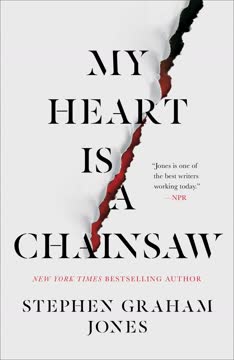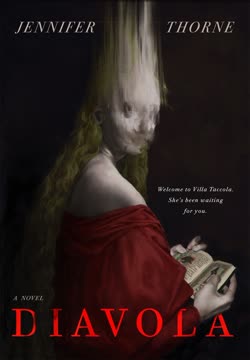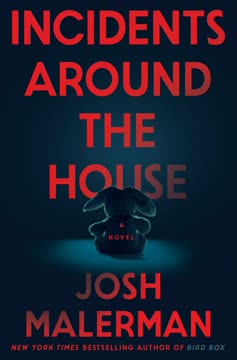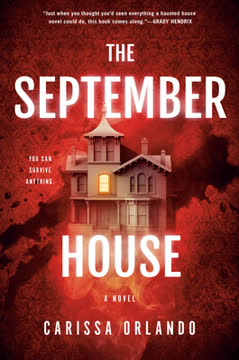Plot Summary
Lake Witch Awakens
Two European tourists, Lotte and Sven, trespass on the dark waters of Indian Lake, Idaho, seeking adventure. Their playful night turns sinister as they encounter something monstrous beneath the surface. The lake, steeped in local legend, claims them both in a gruesome, unseen attack. Their disappearance is the first ripple in a cycle of violence, awakening the mythic Lake Witch and setting the stage for a new slasher narrative. The lake's hunger is rekindled, and the town of Proofrock, already haunted by its bloody history, is about to be drawn into a nightmare. The sense of dread and the supernatural is palpable, as the lake's secrets stir, promising that old wounds and new trespasses will soon demand a price.
Slasher Scholar's Lament
Jade, a half-Indian, half-white teenager, is Proofrock's misfit and slasher film savant. Her life is a patchwork of trauma: an abusive, alcoholic father, an absent mother, and a town that barely tolerates her. She copes by filtering reality through the lens of slasher movies, seeing herself as a caretaker, a Cropsy, a janitor of the town's sins. Her encyclopedic knowledge of horror is both armor and isolation. Jade's longing for a real slasher event is a desperate wish for meaning and justice in a world that has offered her little of either. Her pain is raw, her humor biting, and her hope—twisted as it is—rests on the possibility that horror's rules might finally apply to her life.
Blood Sacrifice at Indian Lake
The deaths of Lotte and Sven are discovered only through a lost phone and a chilling video. Jade, ever the slasher scholar, recognizes these as the "blood sacrifice" that signals the start of a true slasher cycle. The town, however, is oblivious, dismissing the deaths as tragic accidents or the result of wild animals. Jade alone feels the electric thrill and terror of prophecy fulfilled. The lake's appetite is not sated, and the ritual has only begun. The sense of inevitability grows, as Jade's conviction that a slasher is stalking Proofrock hardens into certainty. The town's denial is as dangerous as the killer itself.
Final Girl Arrives
Letha, the beautiful, athletic, and seemingly flawless daughter of a wealthy Black family moving into Terra Nova, becomes the object of Jade's obsession. To Jade, Letha is the archetypal "final girl"—the one destined to survive and defeat the killer. Their first encounter is charged with awe, envy, and longing. Letha's kindness and poise contrast sharply with Jade's rough edges and pain. Jade projects all her slasher theories onto Letha, desperate to prepare her for the coming horror. The emotional stakes rise as Jade's need for connection and validation entwines with her need for the slasher narrative to play out as it should.
Proofrock's Haunted Past
Proofrock is a place where history is never dead. The town's origins are tied to the flooding of Henderson-Golding, the creation of Indian Lake, and a legacy of violence and erasure. Camp Blood, the site of a decades-old massacre, looms over the present. The town's elders, like Mr. Holmes and Sheriff Hardy, carry scars and secrets from the past. The arrival of Terra Nova, a luxury development for the ultra-rich, threatens to erase what little remains of Proofrock's identity. The tension between old wounds and new money, between memory and progress, is palpable. The past is not past—it is waiting to be avenged.
Pranks, Revenge, and Ritual
Jade's essays and rants to her history teacher, Mr. Holmes, lay out the slasher's logic: every cycle begins with a prank or injustice, followed by bloody retribution. The adults' refusal to see the pattern is itself a kind of guilt. Jade's obsession is not just with horror movies, but with the idea that the world can be made fair through violence. The rituals of the slasher—blood sacrifice, the incompetence of authority, the overnight party, the final girl's transformation—are all in motion. Jade's desperate hope is that, by understanding the rules, she can survive, or at least bear witness to, the coming storm.
The Masked Predator
As bodies begin to accumulate—construction workers, townsfolk, and eventually the wealthy newcomers—Jade's theories gain terrifying traction. The killer is both a product of Proofrock's history and a mask for its present sins. Red herrings abound: is the slasher a supernatural force, a vengeful ghost, or a human in disguise? Jade suspects everyone, including herself. The killer's methods are brutal, inventive, and symbolic, echoing the town's buried traumas. The sense of paranoia and dread intensifies, as the line between slasher fiction and reality blurs. The predator is both everywhere and nowhere, and no one is safe.
Graduation and Gentrification
Graduation day is both a celebration and a funeral. The town's youth are leaving, the old ways are dying, and the rich are taking over. The ceremony is haunted by speeches about history, progress, and the gods who walk among mortals. Jade, denied her diploma, is both invisible and infamous. The Founders of Terra Nova, with their promises of scholarships and stewardship, are both saviors and invaders. The town's resentments and divisions are laid bare. The emotional weight of loss, envy, and the fear of being left behind is crushing. The stage is set for a reckoning.
The Bodycount Rises
As the Fourth of July approaches, the killings escalate. The slasher's motives become more personal, targeting those connected to the original sins of Proofrock and the new trespasses of Terra Nova. Jade's warnings go unheeded, her credibility undermined by her outsider status and her own history of trauma. The town's denial and the adults' incompetence allow the killer to move unchecked. The sense of doom is overwhelming, as the rituals of the slasher reach their fever pitch. The emotional toll on Jade and Letha is devastating, as friends and enemies alike fall.
Theories, Red Herrings, and Revelations
Jade's relentless theorizing, her catalog of slasher tropes, and her obsession with the "rules" lead her to suspect everyone—herself, Letha, her father, the town elders, even the supernatural. Red herrings multiply: is the killer a vengeful parent, a wronged child, a supernatural witch, or a product of generational trauma? The truth is more complicated and more horrifying than any movie. The killer is both a mask and a mirror, reflecting the town's collective guilt and Jade's personal pain. The emotional climax is a confrontation not just with the killer, but with the wounds that made them.
Chainsaws and Mother Wounds
The massacre on the water is a symphony of chaos and blood. Jade, Letha, and the survivors are forced to confront not just the killer, but their own histories of abuse, neglect, and longing. The chainsaw—both literal and metaphorical—becomes a symbol of the violence that shapes and scars them. The final girl's journey is not just about defeating the killer, but about surviving the wounds inflicted by family, community, and history. The emotional stakes are at their highest, as love, hate, and the need for justice collide.
The Massacre on the Water
The town's annual movie-on-the-lake celebration becomes a bloodbath. The killer, revealed in a shocking twist, is both more and less than human—a product of myth, trauma, and the town's collective sins. Jade and Letha fight for survival amid the chaos, their bond tested and transformed by violence. The final confrontation is both physical and existential, as the rules of the slasher are rewritten in blood. The emotional arc peaks in terror, grief, and a desperate hope for redemption.
The True Face of Evil
The killer's true identity is revealed: not just a person in a mask, but the embodiment of Proofrock's history of violence, erasure, and betrayal. The Lake Witch, Stacey Graves, is both a ghost and a metaphor—a child sacrificed by the town, returned for vengeance. Jade's confrontation with the killer is also a confrontation with her own trauma, her father's abuse, and the town's refusal to see or care. The emotional impact is shattering, as the line between victim and survivor, between horror and hope, is blurred forever.
Final Girl's Last Stand
In the aftermath of the massacre, Jade is both hero and scapegoat. She has survived, but at immense cost. Her journey from outcast to final girl is marked by pain, rage, and a desperate need for meaning. She has broken the cycle, but not escaped it. The town will never see her as anything but a monster, and she must choose between exile and martyrdom. The emotional resolution is bittersweet: survival is not victory, and justice is never clean. Jade's heart is a chainsaw—wounded, dangerous, and still beating.
Aftermath and Ashes
The fire that consumes Terra Nova and the forest is both destruction and cleansing. Proofrock is forever changed, its sins exposed and its future uncertain. Jade, stripped of everything, finds a strange peace in her survival. The ghosts of the past linger, but there is a glimmer of hope: that the cycle can be broken, that the wounds can begin to heal, that the final girl can become something more than a survivor. The emotional arc closes on loss, resilience, and the faint possibility of redemption.
Characters
Jade Daniels
Jade is the heart and engine of the novel—a half-Indian, half-white teenager whose life is defined by trauma, alienation, and a desperate love of slasher films. Her encyclopedic knowledge of horror is both a shield and a prison, allowing her to make sense of a world that has never protected her. Jade's relationship with her abusive father, her absent mother, and the town that rejects her is fraught with pain and longing. She projects her hopes onto the slasher narrative, seeking justice and meaning in violence. Over the course of the story, Jade transforms from a passive observer and theorist into an active participant and, ultimately, a final girl. Her journey is one of self-discovery, rage, and the search for connection, even as she is forced to confront the darkest truths about herself and her community.
Letha Mondragon
Letha is the beautiful, athletic, and seemingly flawless daughter of a wealthy Black family moving into Terra Nova. To Jade, she is the archetypal "final girl"—the one destined to survive and defeat the killer. Letha's kindness, intelligence, and poise mask her own wounds: the loss of her mother, the pressures of perfection, and the burden of being an outsider in both Proofrock and Terra Nova. Her relationship with Jade is complex—part mentorship, part rivalry, part longing for genuine friendship. As the violence escalates, Letha is forced to confront her own trauma and step into the role Jade has imagined for her. Her transformation is both inspiring and tragic, as she becomes both hero and victim, survivor and sacrifice.
Sheriff Hardy
Sheriff Hardy is the town's aging, world-weary sheriff, marked by the loss of his daughter and the weight of Proofrock's history. He is both a figure of authority and a symbol of the adults' inability to see or stop the coming horror. Hardy's relationship with Jade is paternal, conflicted, and ultimately tragic—he wants to save her, but is powerless against the forces at work. His own guilt and trauma make him both a potential suspect and a red herring. Hardy's arc is one of regret, sacrifice, and the limits of good intentions in a world built on denial.
Mr. Holmes
Mr. Holmes is Jade's favorite teacher and the town's unofficial historian. He is both mentor and skeptic, indulging Jade's slasher obsessions while trying to steer her toward reality. Holmes is haunted by his own past—his role in the town's tragedies, his complicity in its silences. His relationship with Jade is one of mutual recognition: both are outsiders, both are trying to make sense of a world that resists understanding. Holmes's fate is a testament to the dangers of knowing too much and the cost of bearing witness.
Tab Daniels
Tab is Jade's alcoholic, violent father—a man broken by his own history and determined to pass that pain on. He is both a literal and symbolic monster, the source of Jade's deepest wounds. Tab's relationship with Jade is a toxic cycle of abuse, denial, and longing for love that will never come. His presence haunts every page, shaping Jade's worldview and her desperate need for justice. Tab is both victim and perpetrator, a product of Proofrock's legacy of violence and erasure.
Stacey Graves (The Lake Witch)
Stacey Graves is the mythic Lake Witch—a child sacrificed by the town, returned for vengeance. She is both ghost and metaphor, the product of generations of violence, erasure, and betrayal. Stacey's presence is felt in every ripple of the lake, every shadow in the woods. She is the true face of the slasher: not just a killer, but the embodiment of the town's collective guilt and Jade's personal pain. Her arc is one of rage, sorrow, and the desperate need to be seen and remembered.
Theo Mondragon
Theo is Letha's father and one of the Founders of Terra Nova. He is both a symbol of new money and a potential suspect—a man with secrets, wounds, and a complicated relationship with his daughter. Theo's arc is one of suspicion, misdirection, and ultimate tragedy. He is both protector and potential predator, a man trying to build a new world while haunted by the old one.
Rexall
Rexall is the school's janitor and Tab's drinking buddy—a figure of sleaze, voyeurism, and petty power. He is both comic relief and a reminder of the town's capacity for cruelty and neglect. Rexall's relationship with Jade is one of mutual contempt and uneasy alliance. He is a minor monster in a town full of them.
Shooting Glasses (Greyson Brust)
Shooting Glasses is a construction worker at Terra Nova, marked by trauma and guilt. His relationship with Jade is one of tentative friendship, shared pain, and the hope for redemption. He is both a victim and a witness, caught in the crossfire of the slasher cycle. His arc is one of survival, sacrifice, and the possibility of change.
Misty Christy
Misty Christy is a minor but telling figure—a woman who benefits from the town's secrets and is quick to claim heroism when it suits her. She represents the town's capacity for self-deception, its hunger for status, and its willingness to look away from the truth. Her fate is a commentary on the costs of denial.
Plot Devices
Slasher Film Structure and Meta-Narrative
The novel is structured as both a slasher narrative and a commentary on slasher films. Jade's essays, rants, and internal monologues lay out the "rules" of the genre: the blood sacrifice, the incompetence of adults, the overnight party, the final girl's transformation, the killer's mask, the red herrings, and the reveal. The narrative constantly blurs the line between fiction and reality, using Jade's obsession to both foreshadow and shape events. The story is self-aware, using slasher tropes as both plot devices and psychological tools. The meta-narrative is both a shield and a trap, allowing Jade (and the reader) to anticipate horror while questioning the cost of living by its rules.
Generational Trauma and Cycles of Violence
The plot is driven by the idea that violence, injustice, and erasure are never truly buried. The sins of the past—abuse, betrayal, murder, and the destruction of communities—return in the form of the Lake Witch and the slasher cycle. The story uses flashbacks, local legends, and the haunted geography of Proofrock to show how trauma is inherited, denied, and avenged. The killer is both a product of history and a force that demands reckoning. The cycle of violence is both literal (the killings) and metaphorical (the town's refusal to change).
Red Herrings and Misdirection
The narrative is thick with red herrings: multiple potential killers, supernatural explanations, and shifting motives. The adults' incompetence and denial serve as both obstacles and clues. The story uses misdirection to build suspense, challenge the reader's expectations, and force Jade (and the audience) to confront uncomfortable truths. The reveal is both shocking and inevitable, tying together the personal and collective wounds of the town.
The Final Girl and Transformation
The "final girl" trope is both celebrated and deconstructed. Letha is set up as the perfect final girl, but Jade's journey complicates the narrative. The transformation from victim to survivor is both empowering and traumatic. The story interrogates what it means to survive, what is lost in the process, and whether justice is ever truly served. The final confrontation is both physical and existential, forcing the characters to confront their own pain, guilt, and longing for meaning.
Symbolism and Foreshadowing
The novel is rich with symbols: the lake as both womb and grave, the chainsaw as both weapon and heart, the mask as both disguise and revelation. Water is both cleansing and deadly; fire is both destruction and renewal. The story uses foreshadowing—through Jade's slasher essays, local legends, and recurring imagery—to build tension and deepen the emotional impact. The narrative structure itself is a kind of mask, hiding and revealing the truth in equal measure.
Analysis
"My Heart Is a Chainsaw" is a masterful fusion of slasher fiction, psychological horror, and social commentary. At its core, the novel is about the wounds we inherit and the stories we tell to survive them. Stephen Graham Jones uses the language and structure of slasher films not just as homage, but as a way to explore the cycles of violence, denial, and longing that shape individuals and communities. Jade Daniels is both a product and a critic of her world—her obsession with horror is a desperate attempt to find justice, meaning, and connection in a town that has failed her at every turn. The novel interrogates the allure and danger of living by the rules of fiction, the cost of survival, and the possibility of breaking the cycle. The Lake Witch is both a literal monster and a metaphor for generational trauma, demanding that the past be seen, acknowledged, and avenged. The story's emotional arc is one of pain, rage, and the faint hope of healing—a chainsaw heart, still beating, still dangerous, still alive.
Last updated:
Review Summary
My Heart Is a Chainsaw receives mixed reviews, with many praising its homage to slasher films and complex protagonist Jade. Some find the story slow-paced initially but rewarding in its intense finale. Critics appreciate Jones' exploration of deeper themes like race and class. However, some readers struggle with the dense writing style and numerous horror references. The book's graphic content, particularly regarding sexual abuse, is divisive. Overall, it's seen as a unique, character-driven horror novel that may not appeal to everyone but resonates strongly with genre fans.
The Indian Lake Trilogy Series
Similar Books
Download PDF
Download EPUB
.epub digital book format is ideal for reading ebooks on phones, tablets, and e-readers.















